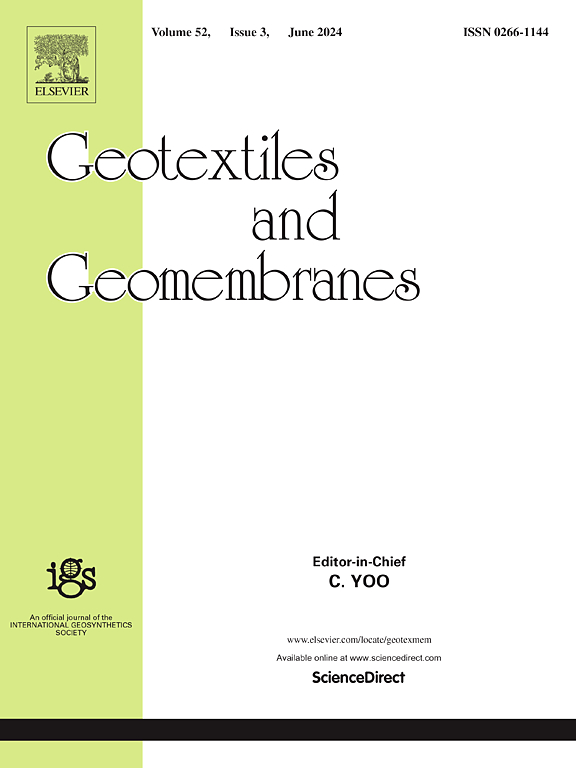刮伤HDPE土工膜拉伸破坏机理及应力-应变行为
IF 6.2
1区 工程技术
Q1 ENGINEERING, GEOLOGICAL
引用次数: 0
摘要
在土工膜防渗应用中,损坏和缺陷几乎是不可避免的,并可能导致其在使用寿命期间过早失效。本研究对有缺陷的gmb进行了一系列室内拉伸试验,以评估各种缺陷类型、位置和几何特征对其破坏行为的影响。通过正交试验验证了缺陷数量和组合方式对GMB性能的影响。在不同划痕几何特征条件下,对不同阶段的划痕性能进行了评价。研究结果表明,与其他缺陷类型相比,划痕对GMB性能的威胁更大。在相同角度下,划痕位置的变化对机械性能的影响可以忽略不计。在划痕的几何特征中,长度和角度是影响划痕性能的主要因素。实际工程应用中,划伤gmb的许用拉应力范围应保持在2.97 ~ 3.50 MPa之间,许用拉应变范围应控制在1.78 ~ 3.30%之间。通过对划伤的gmb各阶段的评估和预测,为设计工程师和gmb的划伤修复提供参考。本文章由计算机程序翻译,如有差异,请以英文原文为准。
Tensile failure mechanism and stress-strain behavior of scratched HDPE geomembranes
In the application of geomembranes (GMBs) for anti-seepage purposes, damage and defects are almost inevitable and can lead to premature failure during their service life. This study conducted a series of indoor tensile tests on defective GMBs to evaluate the effects of various defect types, locations, and geometric characteristics on their failure behavior. The results were validated through orthogonal tests to determine the influence of defect quantity and combination patterns on GMB performance. Furthermore, the performance at different stages was assessed under the condition of varying scratch geometric characteristics. The findings indicate that scratches pose a greater threat to GMB performance compared to other defect types. At the same angle, variations in scratch position have a negligible effect on mechanical properties. Among scratch geometric characteristics, length and angle are the primary factors affecting performance. For practical engineering applications, the allowable tensile stress range for scratched GMBs should be maintained between 2.97 and 3.50 MPa, while the allowable tensile strain range should be confined to 1.78–3.30 %. The evaluation and prediction of each stage of scratched GMBs can provide references for design engineers and the repair of scratched GMBs.
求助全文
通过发布文献求助,成功后即可免费获取论文全文。
去求助
来源期刊

Geotextiles and Geomembranes
地学-地球科学综合
CiteScore
9.50
自引率
21.20%
发文量
111
审稿时长
59 days
期刊介绍:
The range of products and their applications has expanded rapidly over the last decade with geotextiles and geomembranes being specified world wide. This rapid growth is paralleled by a virtual explosion of technology. Current reference books and even manufacturers' sponsored publications tend to date very quickly and the need for a vehicle to bring together and discuss the growing body of technology now available has become evident.
Geotextiles and Geomembranes fills this need and provides a forum for the dissemination of information amongst research workers, designers, users and manufacturers. By providing a growing fund of information the journal increases general awareness, prompts further research and assists in the establishment of international codes and regulations.
 求助内容:
求助内容: 应助结果提醒方式:
应助结果提醒方式:


